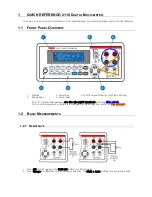
EX503-en-GB_ v5.4 12/15
3
CAUTIONS
Improper use of this meter can cause damage, shock, injury or death. Read and understand
this user manual before operating the meter.
Always remove the test leads before replacing the battery or fuses.
Inspect the condition of the test leads and the meter itself for any damage before operating the
meter. Repair or replace any damage before use.
Use great care when making measurements if the voltages are greater than 25VAC rms or
35VDC. These voltages are considered a shock hazard.
Warning! This is a class A equipment. This equipment can cause interferences in the living
quarters; in this case the operator can be required to carry out adequate measures.
Always discharge capacitors and remove power from the device under test before performing
Diode, Resistance or Continuity tests.
Voltage checks on electrical outlets can be difficult and misleading because of the uncertainty
of connection to the recessed electrical contacts. Other means should be used to ensure that
the terminals are not "live".
If the equipment is used in a manner not specified by the manufacturer, the protection provided
by the equipment may be impaired.
This device is not a toy and must not reach children’s hands. It contains hazardous objects as
well as small parts that the children could swallow. In case a child swallows any of them,
please contact a physician immediately
Do not leave batteries and packing material lying around unattended; they can be dangerous
for children if they use them as toys
In case the device is going to be unused for an extended period of time, remove the batteries
to prevent them from training
Expired or damaged batteries can cause cauterization on contact with the skin. Always,
therefore, use suitable hand gloves in such cases
See that the batteries are not short-circuited. Do not throw batteries into the fire.
































